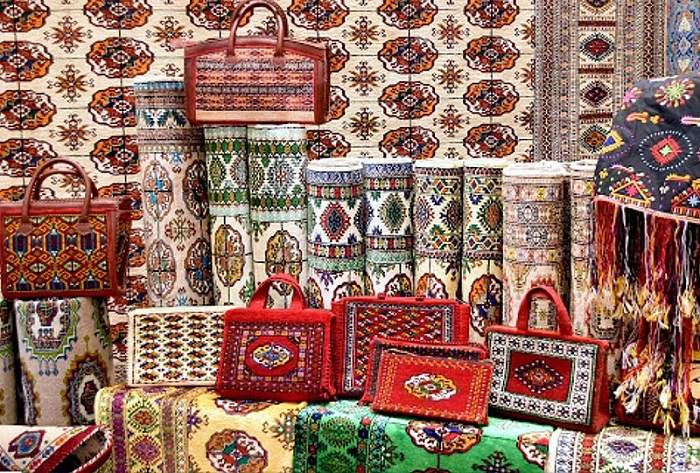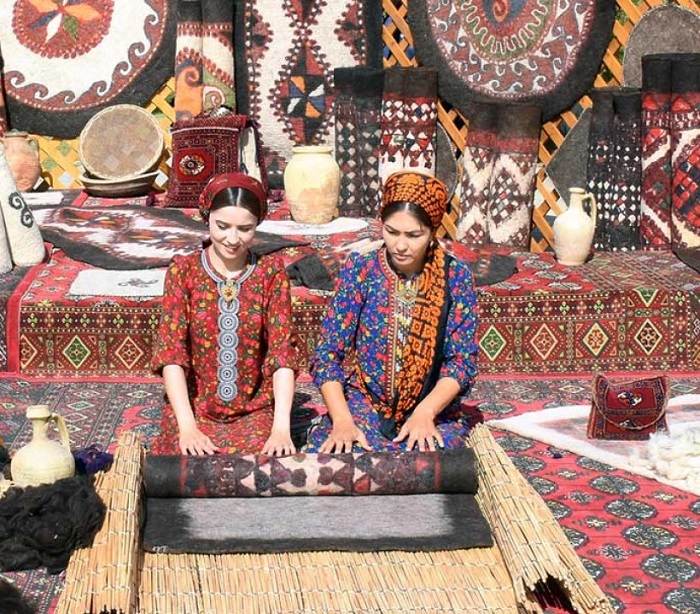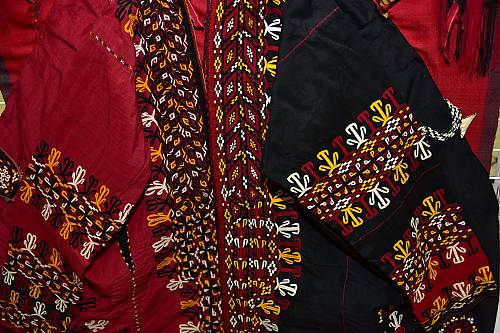Kerim Kertiyev, PhD in Economics, Senior Lecturer, National Institute of Finance, Turkmenistan
Chary Nurmuhammedov, Head of Office, UN Resident Coordinator’s Office
The handicraft making is deeply rooted in the distant past. Since ancient times, Turkmen ancestors had been improving their well-being and the atmosphere in their homes by creating handmade items and objects. Handicrafts represent an occupation that most of the female population of Turkmenistan has been constantly involved in throughout the history. This art continues to maintain the national traditions and continuity of development.
Literature dedicated to these topics is quite extensive. Most of it has a descriptive nature. Materials from XIX and early XX centuries are characterized by the accumulation and publication of archival and statistical data. During this period, scholars mainly published personal observations, which were in the form of essays and overviews. There is very few research from the mid- to late twentieth century dedicated to the economic aspect of this issue. Similarly, present-day studies focusing on the handicraft activity are not many. Studies on this topic during the years of Turkmenistan’s independence are more of a historical and ethnographic nature. The attention of the authors of these studies is more towards history and cultural studies rather than economic theory. There are very few empirical studies exploring the development of this unique craftwork and its place in the country’s national economy.
We decided to study the place and role of craft making and traditions around this activity in Turkmenistan’s national economy, as well as the trends in their modern development. Based on this, we attempted to study the evolution of this linkage. The main conclusion of this work is that the economic reforms and the development of market relations also influence the evolution of the decorative and applied arts that is becoming more widespread and turns into a separate type of labor activity.
Introduction
A semi-nomadic lifestyle in harsh conditions of a sharply continental, arid climate and natural economy taught people to produce everything they needed independently. Influenced by their own way of life, Turkmens, like many other Asian peoples, have managed to preserve the cultural characteristics, traditions, and customs of their ancestors over many centuries. In this regard, they have inherited a unique originality, evident in all areas of life.
Turkmens have long been engaged in home-based production and folk craft making. There has always been a clear division of labor: men were involved in artisanal production that required masculine strength such as woodwork, metalwork, leatherwork, as well as other types of occupation traditionally associated with male activities. On the contrary, handicrafts were not a pastime for women in ancient times; it was their work. Women and girls worked where patience and meticulousness were required. Such activities included wool processing, felting, carpet weaving, various types of braiding and embroidery. Folk crafts satisfied almost all essential needs of people in those times.
Throughout history, a woman engaged in handcraft making embodied all the best qualities – femininity, coziness, domestic warmth, and creativity. All of this transformed and enlivened the household. The life cycle of a family determined every girl’s and woman’s traditional occupation.
Traditional artistic crafts of Turkmen women have not been a subject of special study up until these days. This work was centered around the question of how contemporary craft making affects the level of self-employment of the female population and the status of these activities in the labor market.
Review of Turkmen Crafts and Arts
Over many centuries, Central Asia has been a home to unique centers of handicraft production – both individual and small-scale. Each Central Asian region developed its own specialization which by the early 19th century reached its peak level of development. The active growth of internal and external trade in the region which had started in the second half of the 19th century led to further development of folk crafts.
New imported materials and raw materials allowed artisans to significantly expand their capabilities and realize new ideas. This not only ensured the quality of the products but also distinguished the new items with aesthetic and artistic virtues. Turkmen wool carpets, silk fabric “keteni,” and embroidery patterns for women’s dresses were particularly valued in domestic and foreign markets.
Today, handicrafts serve as a reflection of the rich culture of Turkmenistan, and their products serve as wonderful ethnic gifts and souvenirs. Artistic handmade items contribute to preserving the unique cultural heritage of the nation. They also make a significant contribution to social development and economic independence of the country.
Turkmen Carpets
 Carpet weaving is one of the oldest forms of decorative and applied art of the population of Central Asia. Carpets also represent an example of common ethno-genesis, close interethnic, cultural, and economic ties among peoples of the region. The semi-nomadic way of life led to the creation of diverse carpet products, resulting in unique elements in the carpet styles. Convenient, durable, and practical for transportation, the carpets satisfied various household needs. Each carpet product had its strictly utilitarian purpose, used on ordinary days, celebrations, and in everyday life.
Carpet weaving is one of the oldest forms of decorative and applied art of the population of Central Asia. Carpets also represent an example of common ethno-genesis, close interethnic, cultural, and economic ties among peoples of the region. The semi-nomadic way of life led to the creation of diverse carpet products, resulting in unique elements in the carpet styles. Convenient, durable, and practical for transportation, the carpets satisfied various household needs. Each carpet product had its strictly utilitarian purpose, used on ordinary days, celebrations, and in everyday life.
The Turkmen carpets are made of wool or silk. In addition, there are pile carpets, pileless or smooth carpets. Today, traditional hand-woven carpet making is an integral part of the socio-cultural life of the country.
Felt
 Felt is one of the oldest known textile products made from wool. It is produced by the Turkmen since the ancient times. Production and subsequent processing of felt were one of the main occupations of nomads, and it was exclusively led by women. Felt was usually made of sheep’s wool, rarely from camel’s wool. Primarily, felt was used to cover yurts.
Felt is one of the oldest known textile products made from wool. It is produced by the Turkmen since the ancient times. Production and subsequent processing of felt were one of the main occupations of nomads, and it was exclusively led by women. Felt was usually made of sheep’s wool, rarely from camel’s wool. Primarily, felt was used to cover yurts.
Felt rugs (known as “keche”) were widespread on the territory of Turkmenistan since the ancient times. The patterned “keche” of Turkmens is stronger and more durable than similar felts of other peoples in the region. The ornaments in Turkmen keche are clearer and more concrete compared to the blurry, merging with the background pattern of neighboring peoples. This is entirely the merit of craftswomen and the particularly meticulous manufacturing technology they have developed. Up until now, some craftswomen excel in the technique of creating high-quality, double-sided ornamented felt rugs.
Loom Weaving
 The history of loom weaving dates back to the deep past of humanity. It emerged and developed in the context of household economy and was often a female occupation. Initially, spinning and hand weaving occupied an important place in domestic production. In Central Asia, this activity was closely linked to the production of clothing and other household items.
The history of loom weaving dates back to the deep past of humanity. It emerged and developed in the context of household economy and was often a female occupation. Initially, spinning and hand weaving occupied an important place in domestic production. In Central Asia, this activity was closely linked to the production of clothing and other household items.
Spinning and weaving were extremely widespread across the territory inhabited by settled Turkmen. The cloth they produced were of various types based on their purpose. Fine fabric made from camel wool was highly valued for making robes, while cotton fabric was used for clothing. Rural women produced various fabrics from silk and semi-silk. Weavers, using simple home looms and production techniques, achieved significant results in creating unique national fabrics.
Embroidery
 Embroidery is one of the oldest and most popular forms of creative and domestic craft making. Turkmen clothing is adorned with embroidery of remarkable beauty. The art of creating ornaments on fabrics using needle is a complex, painstaking, attention-demanding activity. Th needlework accompanied the Turkmen women throughout their lives. The skill of silk thread embroidery is a widely diverse cultural phenomenon. Such skills and the virtuoso mastery of embroiderers found application in traditional national costumes. Impeccable embroidery adorned women’s scarves and dresses, men’s shirts, and various clothing details. Over centuries, embroiderers developed various techniques and specific methods of executing national embroidery. They created unique symbols, ornament characters, patterns, and their distinctive color palette. The craftswomen worked on classic proportions, traditional arrangement and proportion of pattern parts, their unity with the garment cut. The forms of wardrobe items being decorated depended on the way the ornamental compositions were placed. All these factors led to the creation of a distinctive form of folk art.
Embroidery is one of the oldest and most popular forms of creative and domestic craft making. Turkmen clothing is adorned with embroidery of remarkable beauty. The art of creating ornaments on fabrics using needle is a complex, painstaking, attention-demanding activity. Th needlework accompanied the Turkmen women throughout their lives. The skill of silk thread embroidery is a widely diverse cultural phenomenon. Such skills and the virtuoso mastery of embroiderers found application in traditional national costumes. Impeccable embroidery adorned women’s scarves and dresses, men’s shirts, and various clothing details. Over centuries, embroiderers developed various techniques and specific methods of executing national embroidery. They created unique symbols, ornament characters, patterns, and their distinctive color palette. The craftswomen worked on classic proportions, traditional arrangement and proportion of pattern parts, their unity with the garment cut. The forms of wardrobe items being decorated depended on the way the ornamental compositions were placed. All these factors led to the creation of a distinctive form of folk art.
Summary
The art of handicraft making has its origins in the distant past of the people. At the same time, it preserves the national traditions and the continuity of development. This unique and exclusive art of folk craftswomen is being passed on from generation to generation as a family legacy. They preserve centuries-old traditions, identity, and the uniqueness of the Turkmen.
The decorative and applied art of the nation has evolved over the centuries, leaving behind unique creations that attest to the multifaceted creative talent of Turkmen women. Women made handicrafts today become exhibits at numerous exhibitions of various levels and orientations – agricultural, artisanal and industrial. These creations continue to amaze contemporaries with the richness of artistic imagination and the perfection of forms. For many generations, these handmade masterpieces have been a source of beauty, historical significance, and national pride.
Handicraft making is one of the types of labor activities constantly present in the national economy. It can be viewed as a separate occupation of the female population. With the reform of the economy and the development of market relationships, it is becoming increasingly widespread. It plays a significant role in adapting the population to the emerging conditions.
At the present stage of the Turkmen society’s development, with its transition to new and innovative technologies, handicraft making acquires qualitatively new orientation which is achieved by means of applying centuries-old experience, knowledge, and know-how.
Considering the current market and economic relationships and trade ties, we believe it is necessary to promote and encourage engagement in this type of activity. Such measures will contribute to a wide engaged population coverage. This also includes stimulating such production through special schemes of preferential taxation (provision of tax holidays or subsidies by the state, for example), expanding export opportunities to enter foreign markets for producers of such products. The benefits of implementing such economic policies are numerous. Firstly, it increases employment, especially for those living in rural areas. Secondly, it contributes to the popularization of Turkmen applied arts, including handicrafts, among both domestic and foreign consumers. As development of tourism becomes a priority in Turkmenistan, concentrating such artisanal production and workshops on major tourist routes will simultaneously increase income for both this sector of the economy and artisans. Additionally, as a result of this regulation, artisans working from home will transition from the informal economy to the formal one.
Nowadays, women’s social roles in families are changing also due to the growing interest in handicrafts. Positive trends in modern self-employment development can be seen in areas where work is of a creative, constructive nature. This fully applies to women engaged in craftmaking industry, allowing for not only the revival and development of national crafts and folk arts but also contributing to women’s self-realization in the process of individual labor activity.
Conclusion
According to the unified terminology of the EU, WTO, and UN, handicraft activity is a type of professional activity involving the small-scale production of goods, work, and services primarily for consumer purposes, individually, including on customer orders. In many European countries, handicrafts are an important part of the economy and are becoming increasingly relevant. Experience from different countries shows that self-employment of the population helps the state address not only economic issues but also social challenges.
In France, the handicraft sector employs more than 2 million people. The country has over 20,000 artisanal enterprises engaged in various activities. More than a third of artisans are employed in construction. The second-largest group consists of artisans involved in repairing various goods. The third-largest group comprises artisans in the food industry. The most numerous among them are bakers, confectioners, chocolatiers, owners of meat and sausage shops.
In Germany, crafts are the most diverse sector of the economy. Small and medium-sized artisan enterprises are the traditional backbone of the German economy. Skilled artisans represent the most multifaceted sector of the German economy, forming the basis of the small and medium-sized enterprise sector.
In Italy, artisan enterprises also make a significant contribution to employment and economic growth. One-third of all enterprises are artisanal, providing jobs for one-fifth of the population. Italian enterprises, despite their small size and “conservative” specialization, have succeeded in capturing a solid niche in the global market due to fashionable and high-quality products under the “Made in Italy” brand. It is worth noting that in recent years, the focus of artisanal enterprises on international markets has intensified in other European countries as well. Therefore, in many developed European countries, handicrafts are an important component of the economy and are becoming increasingly relevant.
The available statistical data do not allow us to assess the size of this growing segment in the Turkmen economy today. This article reviews some aspects of the past and present that make up the handicraft sector in Turkmenistan, as well as its decorative and applied arts. In Turkmenistan, support for the development of small and medium-sized businesses is a priority policy of the state. We have noted a stable trend of Turkmen handicraft products entering the global market. Today, there are many ways to overcome the local limitations of their economic space while simultaneously strengthening their competitive advantages. Promoting such activities is part of an active labor market policy aimed at stimulating this innovative form of entrepreneurship and ensuring gender equality. A set of measures in this direction helps increase the success of self-employed individuals as professionals. In modern times, handicrafts are not only a domestic activity; they also become part of the artistic language, design, and contemporary art. Interest in folk crafts among the younger generation is not diminishing but growing. Preserving the traditions of artistic crafts allows the nation to preserve its ethnic and artistic customs and traditions. ///nCa, 13 June 2024